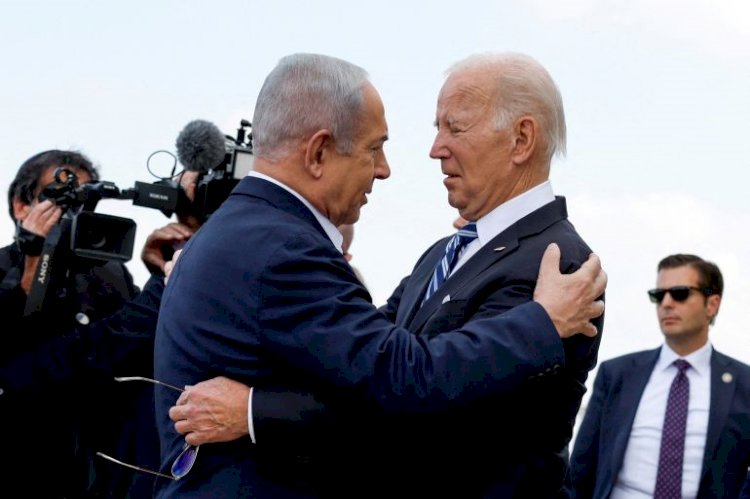American Eyes and Israeli Strikes: The Extent of US Involvement in Israel’s Gaza Genocide
On October 18, 2023, President Joe Biden's plane landed at Ben Gurion Airport. Awaiting him were Israeli Prime Minister Benjamin Netanyahu and President Isaac Herzog. Biden embraced his old friend Netanyahu upon arrival. Later that day, following the bombing of the Baptist Hospital by the Israeli occupation, Biden reassured Israelis, saying, "You are not alone!"
On Saturday, 8 June 2024, the world saw clear evidence of the close relationship between the U.S. and Israel. Despite weeks of tension between the two nations and their leaders, the United States constructed a floating bridge to facilitate aid into Gaza. Soon after, the Israeli military announced the liberation of four hostages, a mission carried out with American intelligence assistance and under the guise of American civilian aid trucks. Reports, including from the Israeli newspaper Haaretz, suggested that the floating bridge might have been used in the operation, potentially undermining American efforts for a ceasefire and exposing the last remnants of American credibility in this war.
Israel has relied on American support for decades. Since World War II, Israel has been the largest recipient of U.S. foreign aid, totalling approximately $158.6 billion between 1946 and 2023. Most of this aid has gone to the military sector, with $114.4 billion for military assistance and $9.9 billion for missile defence. Following the October 7 attack, American support surged, with Congress approving an unprecedented aid package of $14.3 billion in early November 2023.
Intelligence Cooperation
The collaboration between U.S. and Israeli intelligence agencies is crucial for the continuation of Israeli military operations. This cooperation reached a new level with the American-assisted operation to free four hostages. Traditionally, Israeli intelligence agencies have marketed themselves as the eyes and ears of American intelligence in the Middle East. However, under President Donald Trump, the nature of this cooperation deepened, shifting from strategic to tactical and operational.
The current level of coordination includes American intelligence support for identifying Hamas leaders and operational targets in Gaza. The CIA has established a new task force to gather intelligence on Hamas leaders and hostage locations, elevating Hamas to a priority level two, meaning significant resources are now allocated to this task.
It is well known that coordination occurs behind the scenes in a shroud of mystery, with deliberate obfuscation of documentation. The war on Gaza has lifted many veils, bringing shadowy figures into the open and pushing cooperation to its limits. The extent of coordination between American and Israeli intelligence has surpassed strategic thresholds, delving into tactical and field details that have paved the way for continuous bombing and targeted assassinations over the past five months.
A significant aspect of this cooperation has been using the reputation of American intelligence agencies to provide cover for Israeli military actions. This was evident in the Pentagon's claim of an alleged Hamas command post within the Al-Shifa Hospital, based on intelligence later revealed to be misleading. This move was intended to provide a reprieve for Israel amid global outrage over the hospital's siege.
Historically, Israeli intelligence agencies have marketed themselves as the eyes and ears of American intelligence in the Middle East. However, under President Trump, the cooperation deepened significantly. The exchange of information between American and Israeli intelligence moved from a strategic level to detailed, tactical collaboration, especially in operations against Iran.
Extent of US Intelligence Gathering on Hamas
On December 3, 2023, Republican Representative Mike Turner, chair of the House Intelligence Committee, detailed the new phase of American-Israeli intelligence cooperation. He confirmed that the U.S. assists in locating Hamas leaders and works closely with Israel to fill intelligence gaps.
In January 2023, American officials told the New York Times that the CIA created a special task force after the Al-Aqsa Flood operation to gather intelligence on Hamas leaders and hostage locations in Gaza. This new priority has elevated Hamas to the second level, ensuring additional funding for intelligence gathering despite Hamas not posing a direct threat to U.S. security or interests.
Before the Al-Aqsa Flood operation, Hamas was a fourth-level priority, meaning fewer resources were dedicated to intelligence on the group. The top priority remains countries and groups posing a direct threat to the U.S., like China, Russia, North Korea, and Iran.
American intelligence support for Israel's war in Gaza includes tactical intelligence crucial for combat operations, such as identifying targets for airstrikes and assisting in hostage searches. American reconnaissance aircraft, such as the RQ-4 Global Hawk and MQ-9 Reaper drones, play a vital role in gathering intelligence.
This means that the United States is participating with all its equipment and intelligence information to support the occupation state in the ongoing war of genocide in the Gaza Strip. It also means that the events of the Al-Aqsa Flood forced American intelligence agencies to intervene themselves after the intelligence failure of Israeli agencies, especially regarding Hamas, which was the responsibility of the Israeli internal security agency, Shin Bet. Thus, America is now seeking to provide extensive tactical intelligence support for Israel.
For example, after October 7, the U.S. military quickly added more intelligence analysts at the U.S. Central Command headquarters to monitor the situation in the occupied Palestinian territories. They reassigned analysts who had been monitoring armed groups like Al-Qaeda and ISIS to focus on the developments and gather information about the war in Gaza. This was reported by Time magazine based on sources familiar with these changes who requested anonymity. One of these sources mentioned that officials at Central Command, which oversees American military operations in the Middle East, had earlier reduced the number of civilian intelligence analysts monitoring the conflict between the occupation and the resistance over the past three years. Those who remained focused more on the West Bank and understanding the policies of the Israeli government rather than tracking the situation in Gaza.
Israel's Inability to Fight the Information War Alone
American intelligence has warned Israel of Hamas's growing credibility and influence inside and outside the Middle East. Hamas has successfully portrayed itself as the sole armed resistance against an oppressive force, which may undermine Israel's narrative and impact its long-term strategic objectives.
But what does it mean for the American intelligence assistance provided to Israel in the Gaza war to have a tactical intelligence orientation? It means that the support given is of a nature that directly influences combat operations, and this type of intelligence is called actionable intelligence. This term refers to useful and important information that directly contributes to military operations on the ground, such as identifying assassination targets, bombing targets for airstrikes, aiding in the search for hostages, and signals intelligence. All of this is in addition to various reconnaissance operations carried out by American aircraft to gather information and assist Israeli intelligence agencies. This type of information is more specific and has an immediate impact compared to broader strategic intelligence, which is more related to long-term decision-making.
Tactical intelligence includes information for identifying bombing targets. For example, the Israeli military uses artificial intelligence systems to pinpoint bombing targets within the Gaza Strip. It also employs heavy artillery for long-range bombardment. This Israeli bombardment requires pre-acquired intelligence shared by the U.S. Air Force, which sent officers specializing in this precise type of intelligence to Israel in late November, according to a document under the Freedom of Information Act cited by "The Intercept." Experts note that this team of officers provides satellite-based intelligence for targeting inside Gaza.
Another example is reconnaissance operations and information gathering, which are then shared with Israeli intelligence agencies. In early November, the New York Times, citing U.S. Department of Defense officials, reported that the U.S. military was flying surveillance drones over Gaza. The objective was to search for hostages held by Palestinian resistance. As the newspaper indicated, this "unprecedented step" suggests a deeper involvement of American intelligence agencies than previously known.
A Thousand Eyes in the Sky
The U.S. military provides extensive intelligence support to Israel in its operations over Gaza, primarily through advanced reconnaissance aircraft and drones. Notable among these are the Boeing P-8 Poseidon, used for maritime patrol and intelligence gathering, and the RC-135, equipped with sophisticated sensors for real-time data collection. Additionally, drones like the RQ-4 Global Hawk and the MQ-9 Reaper play crucial roles in continuous surveillance and targeting, with the Reaper being particularly significant for its ability to carry out strikes and intercept communications.
It is impossible to fully know the details of the tactical intelligence support that Washington provides, but we can investigate and infer its various types and magnitude in the current war on Gaza. Al Jazeera's Sanad News Verification Agency has provided us with a set of important analyses and data. After analyzing navigational data for more than 2,600 military flights from October 7 to January 15, obtained from Radarbox.com, the data showed that around 230 military transport flights headed to Israel, along with 360 flights to military bases in Cyprus, Greece, and Italy, totalling over 600 military cargo flights.
Aerial intelligence support was reflected in reconnaissance flights that provide intelligence to agencies. The New York Times reported that the U.S. intelligence agency intensified its efforts to gather information on Hamas by increasing the frequency of drone reconnaissance flights over Gaza. Sanad analyzed around 1,100 reconnaissance flights, with about 800 conducted by the Israeli Air Force, 150 by the Royal Air Force, and approximately 110 by the U.S. Air Force. These are the flights visible on radar, suggesting the actual number might be higher as some intense reconnaissance missions by U.S. forces do not appear on radar.
Unconditional Support, Despite Opposition
This unconditional American support has stirred discontent among several U.S. officials, prompting calls for scrutiny. Brian Finucane, a consultant with the International Crisis Group's U.S. program, highlighted that intelligence support could raise more concerns than traditional military aid, particularly tactical information shared between American and Israeli intelligence, such as bombing targets and reconnaissance operations. Some U.S. Senators believe military aid should not continue without conditions, with over ten Democratic senators proposing an amendment to impose restrictions on military assistance to Israel.
The United States has the tools to pressure Israel beyond mere statements by officials. These tools could potentially end the war in Gaza if there is the will to use them. Washington could, for instance, impose scrutiny on military aid, stop defending Israel at the United Nations, or halt the intelligence support provided during the conflict. Some Democratic congressmen even proposed a bill to limit the sharing of intelligence with Israel, but the Biden administration strongly opposed all these moves.
Therefore, unconditional American support for Israel continues, driven by the strongest voices within the U.S. government insisting on its continuation. While Israel has not yet become a significant burden on the United States as a major regional and global power, this possibility draws closer day by day.
This article is a translation of an Arabic article published on the Al Jazeera website by the author.
Disclaimer
The views expressed in this article are the author’s own and do not necessarily mirror Islamonweb’s editorial stance.
























Leave A Comment